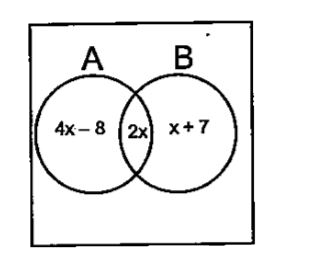For any three sets A,B C, prove that :
n(A∪B∪C)=[n(A)+n(B)+n(C)+n(A∩B∩C)]−[n(A∩B)+n(B∩C)+n(A∩C)].
To prove the equation n(A∪B∪C)=(n(A)+n(B)+n(C)+n(A∩B∩C))−(n(A∩B)+n(B∩C)+n(A∩C)), we will use the principle of inclusion-exclusion.
1. Understanding the Sets:
- Let A,B,C be three sets. We need to find the number of elements in the union of these sets, A∪B∪C.
2. Using Inclusion-Exclusion Principle:
- The inclusion-exclusion principle states that to find the number of elements in the union of multiple sets, we can start by adding the sizes of the individual sets and then subtracting the sizes of their pairwise intersections, and finally adding back the size of the intersection of all three sets.
3. Write Down the Formula:
- According to the inclusion-exclusion principle for three sets, we have:
n(A∪B∪C)=n(A)+n(B)+n(C)−n(A∩B)−n(B∩C)−n(A∩C)+n(A∩B∩C)
4. Rearranging the Formula:
- We can rearrange the formula to match the form we need to prove:
n(A∪B∪C)=(n(A)+n(B)+n(C)+n(A∩B∩C))−(n(A∩B)+n(B∩C)+n(A∩C))
5. Conclusion:
- Thus, we have shown that:
n(A∪B∪C)=(n(A)+n(B)+n(C)+n(A∩B∩C))−(n(A∩B)+n(B∩C)+n(A∩C))
- This completes the proof.
- Let A,B,C be three sets. We need to find the number of elements in the union of these sets, A∪B∪C.
- The inclusion-exclusion principle states that to find the number of elements in the union of multiple sets, we can start by adding the sizes of the individual sets and then subtracting the sizes of their pairwise intersections, and finally adding back the size of the intersection of all three sets.
- According to the inclusion-exclusion principle for three sets, we have:
n(A∪B∪C)=n(A)+n(B)+n(C)−n(A∩B)−n(B∩C)−n(A∩C)+n(A∩B∩C)
- We can rearrange the formula to match the form we need to prove:
n(A∪B∪C)=(n(A)+n(B)+n(C)+n(A∩B∩C))−(n(A∩B)+n(B∩C)+n(A∩C))
- Thus, we have shown that:
n(A∪B∪C)=(n(A)+n(B)+n(C)+n(A∩B∩C))−(n(A∩B)+n(B∩C)+n(A∩C))
- This completes the proof.
Topper's Solved these Questions
- SETS BOOK - MODERN PUBLICATIONCHAPTER - SETS EXERCISE - OBJECTIVE TYPE QUESTIONS (A )(MULTIPLE CHOICE QUESTIONS)
30 Videos
- SETS BOOK - MODERN PUBLICATIONCHAPTER - SETS EXERCISE - OBJECTIVE TYPE QUESTIONS (B) (FILL IN THE BLANKS )
10 Videos
- SETS BOOK - MODERN PUBLICATIONCHAPTER - SETS EXERCISE - Exercise
8 Videos
- SEQUENCES AND SERIESBOOK - MODERN PUBLICATIONCHAPTER - SEQUENCES AND SERIESEXERCISE - CHAPTER TEST
12 Videos
- STATISTICSBOOK - MODERN PUBLICATIONCHAPTER - STATISTICSEXERCISE - Chapter Test
7 Videos
Similar Questions
Given that n(A)=25,n(B)=15,n(A∪B)=10. Determine n(A∩B)
View SolutionIf A , B and C are three non - empty finite sets such that n (A) =19 , n (B) = 15 , n (C ) =17, n(∩B)=11,n(B∩C)=6,n(C∩A)=7andn(A∩B∩C)=5. Also n (U) =50.
(i) n(A∩Bc∩Cc)
(ii) n(B∩Cc∩Ac)
(iii) n(C∩Ac∩Bc)
(iv) n(C∩B∩Cc)
(v) n(B∩C∩Ac)
(vi) n(C∩A∩Bc)
(vii) n(A∪B∪C)
(viii) n((A∪B∪C)c).
View Solution
Knowledge Check
If A,B,C are subsets of the universal set U such that n(U)=692,n(B)=230,n(C)=370,n(B∩C)=20,n(A'∩B'∩C')=10 then: n(A∩B'∩C')=
A876B784C172Dnone of these.If A and B are subsets of the universal set E such that n(E)=50,n(A)=35,n(B)=22andn(A'∩B')=3, then: n(A∩B)andn(A∪B) are respectively
A(47,10)B(45,25)C(12,47)Dnone of these.If n(A)=3,n(B)=5andn(A∩B)=2, then: n(A×B)=
A6B36C15Dnone of these.
If A and B are two non empty sets the prove the following1.n(A∪B)=n(A)+n(B)−n(A∩B). 2.nA∪B∪C)=n(A)+n(B)+n(C)−n(A∩B)−n(B∩C)−n(C∩a)+n(A∩B∩C)
View SolutionIf A and B are two sets such that n(A)=12, n(B)=19 and (A∪B)=26 then find.
(a) n(A∩B)
(b) n(A−B)
(c) n(B−A)
View SolutionLet A and B be two sets such that :
(i) n(A)=20,n(A∪B)=42andn(A∩B)=4
(ii) n(A)=17,n(A∪B)=38andn(A∩B)=2. Find n (B) , n (A-B) and n (B-A).
View SolutionIf n (A)=n(B) , find n (A∩B)andn(A∪B) use the fig

View SolutionIf n(A∩B)=51,n(A)=20,n(B)=44,find n(A∪B).
View Solution
